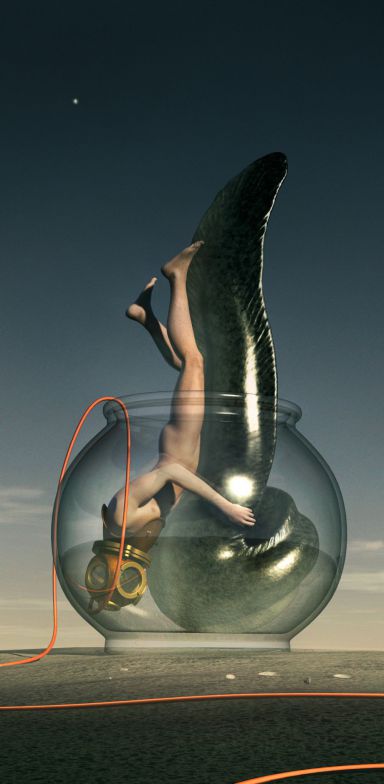The sky is the limit
As earth dwellers we are limited, nailed to the ground, envious of the gravity defying beings who inhabit the works of Ole Tersløse Jensen.
Barmy? No doubt. No other adjective so aptly describes Tersløse Jensen’s topsy-turvy universe. From photographs and computer-aided graphics the ar-tist creates hybrid beings that defy anatomical classification: men with wings, animals that meditate or search for revelation, carrier-pigeons in political role play, Luther as a dubious magician, and others, better still. These encounters of the third, fourth and fifth kind transform our familiar world into a testing ground between the imaginary and the real, where the eye can at leisure escape into the absolute of the irrational. The locations chosen are frequently deserted, vast spaces where a low horizon plunges the eye downward. An unsettling eeriness prevails.
Surrealist? Undoubtedly Tersløse Jensen’s is fully aware of the artistic movement whose raison d’être was the imaginary and dreamlike. Indeed for political reasons the Surrealists (Hannah Höch, Raoul Hausmann...) made significant use of photomontage. Nevertheless, the unreal in this Danish ar-tist’s work is located not only in the metamorphoses to which he subjects his “actors”. His human beings (?), alone or isolated within a group, seem to perform strange rituals and participate in expansive ceremonies. Their carefully executed, absurd gestures and frozen attitudes appear to be part of an incongruous ballet.
There is good reason for this mutative approach to be likened to postmodernism, with its chronological and cultural overlays. The photographs Tersløse Jensen uses immediately call to mind neoclassical painting, with added irony. His characters, which can be likened to Greek sculptures, are equipped with modern machines hurtling into space. Luther kneels in front of a mannerist ascension in which a figure takes to the air on a “flying carpet” made of a sheet of paper. Male figures in a landscape borrowed from Friedrich engage in strange interaction with dubious-looking birds.
In short, this is a postmodernism that, as in a dream, does not shy away from incoherence or contradiction and allows for a touch of madness. In the words of Diderot: “There is no great artist who has not received a hammer blow to the head.”
Barmy indeed; you were warned.
Itzhak Goldberg
Art Historian

